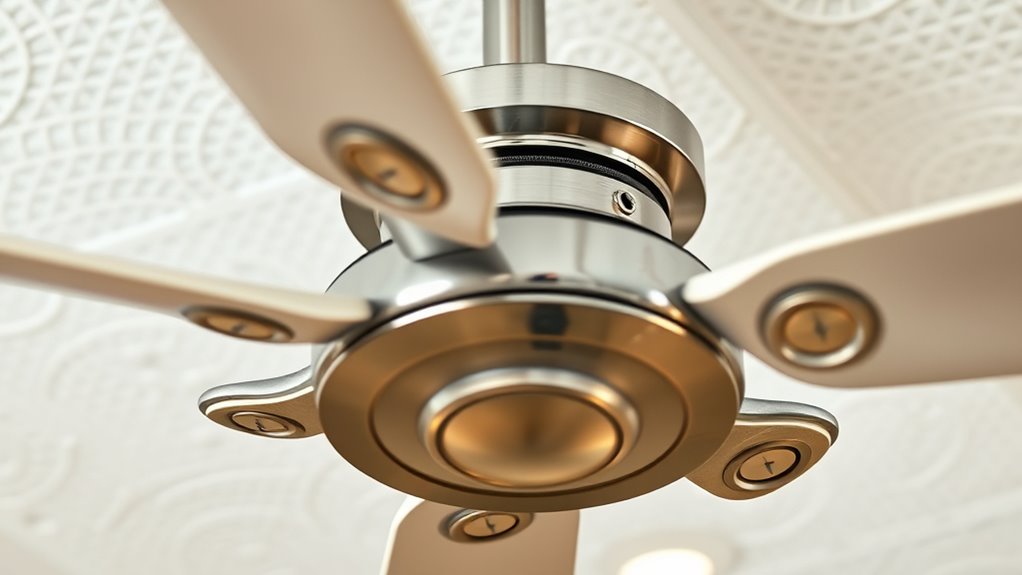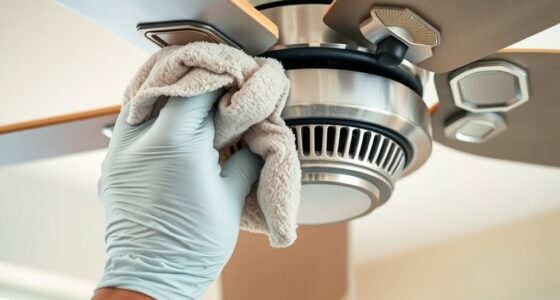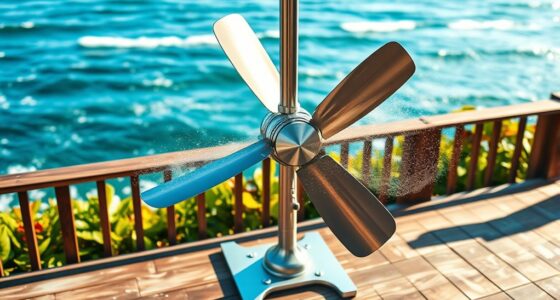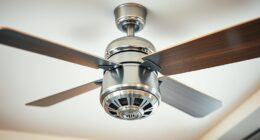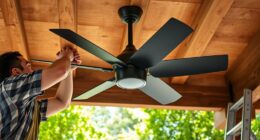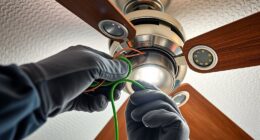Wobbling occurs when your ceiling fan blades are unbalanced, misaligned, or loosely secured. Dust, dirt, or damage can shift blade weight, causing vibrations. Loose mounting screws or bent brackets can also lead to wobbling. Ensuring blades are clean, properly balanced, and firmly attached, along with tightening the motor mounts and checking the ceiling surface, can fix the issue. Continuing this guide will help you learn precise steps to stabilize your fan effectively.
Key Takeaways
- Inspect and clean fan blades regularly to prevent dust and debris buildup that causes imbalance.
- Use a balancing kit to add weights to lighter blades and restore even weight distribution.
- Ensure blades are securely fastened and check for damaged or warped blades that need replacement.
- Tighten motor mounts and mounting brackets to prevent shifting that causes wobbling.
- Verify the ceiling surface is level and attach the mounting hardware to a solid support for stability.

Ceiling fans wobble when their blades become unbalanced or misaligned, disrupting smooth rotation. This common issue can be traced to several specific causes that directly impact the fan’s stability and performance. Understanding these causes enables you to diagnose and address the problem effectively, ensuring excellent operation and reducing wear on the fan’s components.
One primary cause of wobbling is uneven blade weight distribution. Over time, dust accumulation, dirt, or moisture can cause some blades to gain weight relative to others, throwing off the balance. Additionally, manufacturing inconsistencies or damage to blades—such as cracks or warping—can create discrepancies that lead to uneven rotation. To correct this, you should periodically inspect the blades for dirt, debris, or damage, and clean or replace them as necessary. Using a blade balancing kit, you can add small weights to the lighter blades to restore evenness, which considerably reduces wobbling.
Uneven blade weight from dust, damage, or manufacturing issues causes ceiling fan wobbling.
Misalignment of blades is another common issue. If blades are not securely fastened or if their mounting brackets are bent or loose, the rotation becomes uneven. Over time, vibration or improper installation can cause blades to shift or loosen. To fix this, tighten all mounting screws, brackets, and blade attachments, ensuring each blade is securely fastened to its mounting point. If you notice any bent brackets or damaged blades, replace or repair these components before testing the fan’s operation.
The motor’s mounting can also contribute to wobbling if it is loose or improperly aligned. A loose motor mount allows the entire fan assembly to shift during operation, resulting in wobble. To address this, turn off and safely access the motor housing, then tighten all mounting bolts. Confirm that the fan’s mounting bracket is secure and properly aligned with the ceiling. If the bracket itself is bent or damaged, replace it to restore stability.
Finally, the ceiling surface or mounting hardware can influence wobbling. An uneven ceiling surface or a poorly installed mounting plate can cause the fan to sway or wobble during operation. Ensure the mounting bracket is firmly attached to a ceiling joist or a suitable anchoring point. Use a level to verify that the mounting surface is even, and make adjustments if necessary. Installing the fan on a solid, level surface minimizes movement and enhances stability.
Additionally, considering the use of high-quality projectors and proper installation techniques can help ensure your home setup remains stable and wobble-free, especially when mounting or adjusting equipment in your entertainment space.
Frequently Asked Questions
Can Wobbling Damage My Ceiling Fan Over Time?
Yes, wobbling can damage your ceiling fan over time by causing wear on the motor, bearings, and mounting hardware. The imbalance puts extra stress on components, potentially leading to premature failure or costly repairs. To prevent this, guarantee the fan blades are balanced, securely attached, and the mounting bracket is stable. Regular maintenance and prompt correction of wobbling issues extend your fan’s lifespan and ensure safe operation.
How Often Should I Inspect My Ceiling Fan for Wobbling?
You should inspect your ceiling fan monthly to catch wobbling early. Imagine a tiny imbalance causing a ripple effect, gradually loosening screws or misaligning blades. Regular checks help you spot loose mounting hardware, bent blades, or unbalanced weights. Use a flashlight and visual inspection, then test run the fan at high speed. Preventative maintenance keeps your fan stable, quiet, and extends its lifespan by addressing issues before they escalate.
Is Wobbling More Common in Certain Ceiling Fan Brands?
Yes, wobbling is more common in certain brands, especially lower-quality or poorly manufactured fans. These often lack precise balancing components or durable blades, increasing instability. Brands with higher manufacturing standards and quality control, like Hunter or Minka-Aire, tend to experience less wobbling. To minimize this issue, always select reputable brands, regularly inspect your fan, and perform necessary balancing or blade adjustments as needed.
Can Installing a Ceiling Fan on an Uneven Ceiling Cause Wobbling?
Installing a ceiling fan on an uneven ceiling can cause wobbling because the fan’s mounting isn’t perfectly level, leading to imbalance during operation. This misalignment increases vibrations, resulting in wobbling and noise. To prevent this, verify your ceiling is as level as possible before installation. Use a level during mounting and consider shimming the mounting bracket if the ceiling is uneven, maintaining proper balance for smooth fan operation.
Does the Type of Ceiling Material Affect Fan Wobbling?
Your ceiling material acts like the stage for your fan’s performance, directly influencing wobbling. Hard surfaces like concrete or drywall typically offer stable mounting, reducing vibrations. Conversely, softer materials such as plaster or wood may cause instability, amplifying wobbling. Make certain your mounting bracket is secure and use appropriate anchors if needed. Proper installation tailored to your ceiling material minimizes imbalance, ensuring smooth operation and extending your fan’s lifespan.
Conclusion
A wobbling ceiling fan isn’t just a minor annoyance; it’s a sign that something’s off with your setup. By ensuring blades are balanced, checking mounting brackets, and tightening hardware, you restore smooth operation and prevent further damage. Remember, a stable fan isn’t just about comfort—it’s about safety and efficiency. Don’t let imbalance turn your ceiling into a battleground; instead, take these precise steps to keep your fan spinning flawlessly, transforming your space into a haven of stability and serenity.
